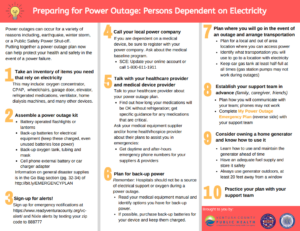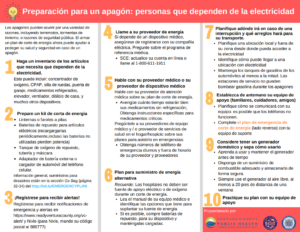Preparing for Power Outage
Preparing for a multi-day power outage
Power outages can occur for a variety of reasons including earthquake, winter storm, or public safety power shutoff (PSPS). Putting together a power outage plan now can help protect your health and safety in the event of a power failure.
Download the planning flyer, preparing for power outage: persons dependent on electricity, in english and spanish.


What is a Public Safety Power Shutoff (PSPS)?
Southern California Edison and PG&E have developed plans to shutoff power during critical fire weather in order to reduce the risk of wildfire. The Public Safety Power Shutoff (PSPS) could lead to multi-day outages in many areas during periods of extremely hot, dry and/or windy weather. A PSPS outage will last as long as the potentially dangerous weather conditions exist, plus the amount of times it takes for power company workers to inspect and repair their equipment in the affected area(s). Residents need to be prepared to endure a power outage lasting 3-5 days.
What does this mean for Ventura County residents?
Power outages impact the whole community and can make it difficult for people to meet their basic needs, as well as:
- Disrupt communications, water, air conditioning and transportation
- Close retail business, grocery stores, gas stations, ATMs, banks and other services
- Cause food spoilage and water contamination
- Prevent the use of medical devices such as oxygen concentrators and other devices
- Prevent the use of elevators, garage doors, electric gates and doors, etc.
Additional Resources:
- Preparing for Power Down
This website provides a variety of resources, including tips for preparing for extreme weather, wildfires and Public Safety Power Shutoffs. An emergency preparedness checklist and additional resources are available on the English and Spanish fact sheets. - California Public Utilities Commission (CPUC) De-energization (PSPS)
- The CPUC has a de-energization page that contains information on the Public Safety Power Shutoffs such as: CPUC Actions, Schedule, Utility PSPS Programs, Consumer Protections, and Potential Impacts on Telephone Services during De-energization.
- Additionally, per Resolution ESRB-8, the electric utilities companies must submit a report within 10 days after each de-energization event, and after high-fire-threat events where the utility provided notifications to local government, agencies, and customers of possible de-energization though no de-energization occurred. These reports are made available to the public on the CPUC De-energization page.
- Southern California Edison (SCE)
SCE customers can sign up to receive Outage Alerts direct from SCE via voice, email or text message by going to their Outage Alert Preferences page in the sce.com customers’ profile. A sce.com User ID will be required to sign up – if you don’t have one, you can register for an User ID through SCE.
What if you depend on electricity for a medical device?
During a PSPS all customers serviced by an affected power line will have their power shut off. If you rely on electric or battery dependent devices such as oxygen concentrator, ventilator, electric wheelchair, at home dialysis, refrigerated medications and many other devices; it is critical that you have a plan in place for a multi-day power outage. If you rely on electricity and battery dependent medical devices and assistive technology we encourage you to start preparing now by following these ten steps:
1. TAKE AN INVENTORY OF ITEMS YOU NEED THAT RELY ON ELECTRICITY
This can include: oxygen concentrator, CPAP, electric wheelchairs, garage door, refrigerated medications, elevator, ventilator, at home dialysis machines, and many other devices.
2. ASSEMBLE A POWER OUTAGE KIT
- Battery operated flashlights or lanterns
- Back up batteries for electrical medical equipment (charge them periodically; even unused batteries lose power)
- Back-up oxygen tank, tubing, and mask
- Cell phone or car charger
- Cash in small bills
These items are in addition to your general disaster supply kits at: https://www.ready.gov/kit
3. SIGN-UP FOR ALERTS!
Sign up for emergency notifications at www.readyventuracounty.org/vc-alert and Nixle alerts by texting your zip code to 888777.
4. CALL YOUR LOCAL POWER COMPANY
If you are dependent on an assistive device, be sure to register with your power company. Ask about the medical baseline program.
- SCE Medical Baseline or call 1-800-447-6620
- PG&E Medical Baseline or call 1-800-743-5000
5. TALK WITH YOU HEALTHCARE PROVIDER AND MEDICAL DEVICE PROVIDER
Talk to your healthcare provider about your power outage plan.
- Find out how long your medications will be OK without refrigeration; get specific guidance for any medications that are critical.
Ask your medical equipment supplier and/or home health or hospice provider about their plans to assist you in emergencies:
- Get daytime and after hours emergency phone numbers for your suppliers & providers.
6. PLAN FOR BACK-UP POWER
Remember: Hospitals should not be a source of electrical support or oxygen during a power outage.
- Read your medical equipment manual and identify options you have for back-up power
- Purchase back-up batteries, if possible, for your device(s) and keep them charged
7. PLAN WHERE YOU WILL GO IN THE EVENT ON AN OUTAGE AND ARRANGE TRANSPORTATION
- Plan for a local and out of area location where you can access power. The closest locations may not be usable because they may also be impacted. (Remember to consider accessibility for your daily activities at the planned locations).
- Identify what transportation you will use to get to a location with electricity – this could include your own car, friend, family or transportation services you use on a regular basis. Ensure the vehicles planned for your transportation have room for and are accessible to you and your equipment.
- For vehicle owners: remember to keep car gas tanks at least half full and encourage your support team to do the same
- Remember, gasoline might not be available as pumps at stations might not work during outages.
8. ESTABLISH YOUR SUPPORT TEAM IN ADVANCE (FAMILY, CAREGIVER, FRIENDS)
- Create a support team of people willing to help each other during an emergency. This can include friends, family, caregivers, personal assistants and others at places you spend your time. If you create a large team, you are more likely to get help when you need it.
- Plan how you will communicate with your support team at home, work, etc. via: landline phone, cell phone, email, social media, text message, etc.
- Phones may not work so arrange for your support team to check in on you.
- Download the planning flyer, Preparing for Power Outage: Persons Dependent on Electricity and complete page two, My Power Outage Emergency Plan, with your support team.
9. CONSIDER OWNING A HOME GENERATOR AND KNOW HOW TO USE IT
- Learn how to use and maintain the generator ahead of time.
- Have an adequate fuel supply and store it safely.
- Always use the generator outdoors, at least 20 feet away from a window.
10. PRACTICE YOUR PLAN WITH YOUR SUPPORT TEAM
Give it a run-through! Practice contacting your support team.







